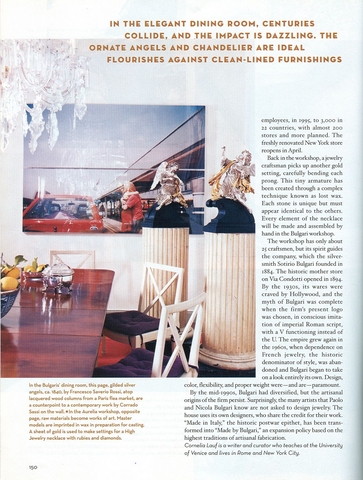
IN THE ELEGANT DINING ROOM, CENTURIES COLLIDE, AND THE IMPACT IS DAZZLING. THE ORNATE ANGELS AND CHANDELIER ARE IDEAL FLOURISHES AGAINST CLEAN-LINED FURNISHINGS employees, in I995, to 3,000 in 22 countries, with almost 200 stores and more planned. The freshly renovated New York store reopens in April. Back in the workshop, a jewelry craftsman picks up another gold setting, carefully bending each prong. This tiny armature has been created through a complex technique known as lost wax. Each stone is unique but must appear identical to the others. Every element of the necklace will be made and assembled by hand in the Bulgari workshop. The workshop has only about 25 craftsmen, but its spirit guides the company, which the silversmith Sotirio Bulgari founded in I884. The historic mother store on Via Condotti opened in I894. By the I930s, its wares were craved by Hollywood, and the myth of Bulgari was complete when the firm's present logo was chosen, in conscious imitation of imperial Roman script, with a V functioning instead of the U. The empire grew again in the I960s, when dependence on French jewelry, the historic denominator of style, was abandoned and Bulgari began to take on a look entirely its own. Design, color, flexibility, and proper weight were-and are-param~)Unt. By the mid-I990s, Bulgari had diversified, but the artisanal origins of the firm persist. Surprisingly, the many artists that Paolo and Nicola Bulgari know are not asked to design jewelry. The house uses its own designers, who share the credit for their work. "Made in ltaly," the historic postwar epithet, has been transformed into "Made by Bulgari," an expansion policy based on the highest traditions of artisanal fabrication. Cornelia Lauf is a writer and curator who teaches at the University of Venice and lives in Rome and New York City. In the Bulgaris' dining room, this page, gilded silver angels, ca. 1840, by Francesco Saverio Rossi, atop lacquered wood columns from a Paris flea market, are a counterpoint to a contemporary work by Corrado Sassi on the wall. -In the Aurelia workshop, opposite page, raw materials become works of art. Master models are imprinted in wax in preparation for casting. A sheet of gold is used to make settings for a I-Ugh Jewelry necklace with rubies and diamonds.
|